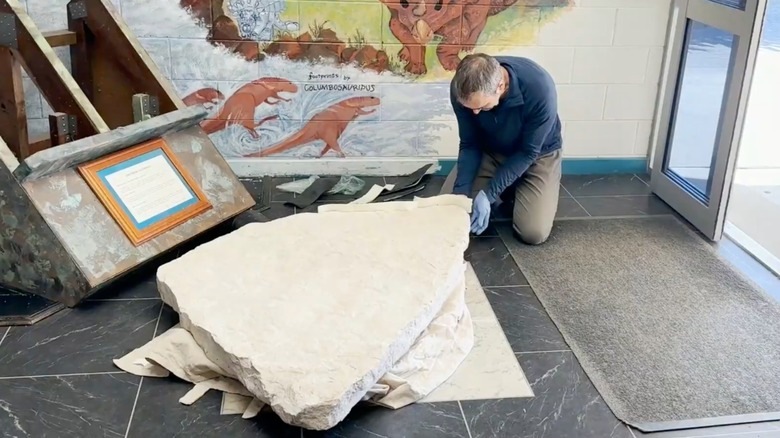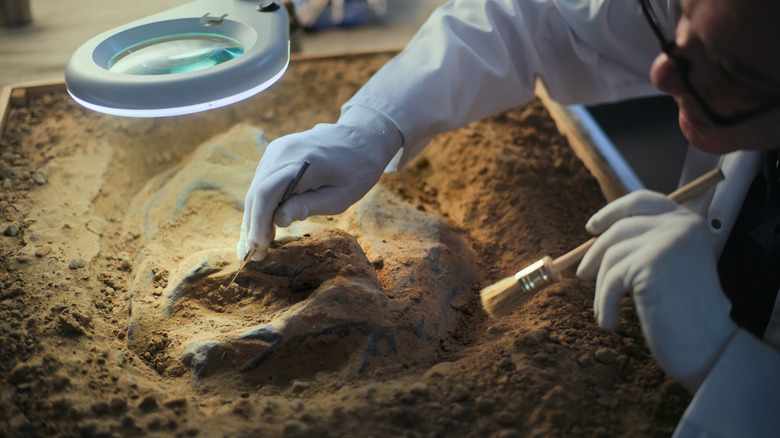The Unexpected Australian Fossil Hiding In Plain Sight For Decades
Roughly 200 million to 174 million years ago, the continents as we know them today had yet to form, and the earlier supercontinent of Pangaea had just begun to split into two landmasses — Laurasia to the north and Gondwana to the south. The discovery of fossils from this time, the Early Jurassic period, are a cause for great excitement among paleontologists. Particularly in Australia, where they are very rare, especially when they are discovered on an otherwise unremarkable rock placed in the lobby of an Australian school. And even more so when that rock is found to contain evidence of 47 individual creatures, all of which are dinosaurs, that give fresh insights into their movement and behavior. Remember: Even we only recently uncovered the sounds that dinosaurs made.
The boulder was uncovered in a mine in Callide, Queensland in 2002. It fell into the possession of geologist Wes Nichols, who donated it to Biloela State High, a school at which his wife worked as a teacher. The expert examining the boulder was Dr. Anthony Romilio, a paleontologist at the University of Queensland Dinosaur Lab, who was contacted by the school after staff became aware of fossil research he had undertaken in Mount Morgan (also Queensland). Though the school had known about the footprints on the rock for years, nobody had checked if they were actually from dinosaurs. Romilio cleaned the boulder, took casts of the prints, and was soon able to confirm that there were more than 60 on the rock.
The fossil is significant because it shows how densely populated Australia once was with dinosaur life. "Around that Early Jurassic period, they seem to be all over the place," Romilio remarked after the finding (per The Guardian). And that finding could have pretty big implications.
An insight into the Early Jurassic period
Dr. Anthony Romilio's discovery is hugely significant for Australian palaeontology because, thus far, not a single bone of an Early Jurassic dinosaur has turned up on the continent. The first dinosaur bone in the region, known as the "Cape Paterson Claw," was discovered in Victoria in 1903, raising hopes that it may prove to be a fruitful paleontology site. However, despite its huge mass, Australia has yielded relatively little for Jurassic experts to investigate over the past 120 years.
The reason lies in several geological factors, including the fact that remains from the period in question are generally buried incredibly deep below ground, and the country lacks exposed rock that hasn't already been eroded away by time and weather conditions. As recently as 2019, academics in Gondwana Research described the Australian Jurassic fossil record as "extremely sparse." However, a younger intact specimen, dating from around 100 million years ago, was unearthed in Queensland in 2022.
More potential discoveries
It's no wonder then that the Queensland school boulder has been such a cause for celebration. The bird-like prints have been identified as belonging to an ichnospecies named Anomoepus scambus, a small herbivore with long hind legs and short forearms, with a posture similar to that of the tyrannosaurus rex. The creatures possibly made the prints in the muddy bank of a river.
The discovery raises hopes for potentially many more fossil discoveries in Australia from the Early Jurassic period, including the first actual dinosaur bones. Dr. Anthony Romilio has since examined another boulder, placed near the parking lot of the mine from which the school artifact was first extracted more than two decades ago and found that it too contained dinosaur prints. He hopes that tip-offs from a public increasingly aware of Australia's prehistoric past may soon uncover new unexpected treasures and show that the continent's Early Jurassic treasures aren't as rare as we once thought.

